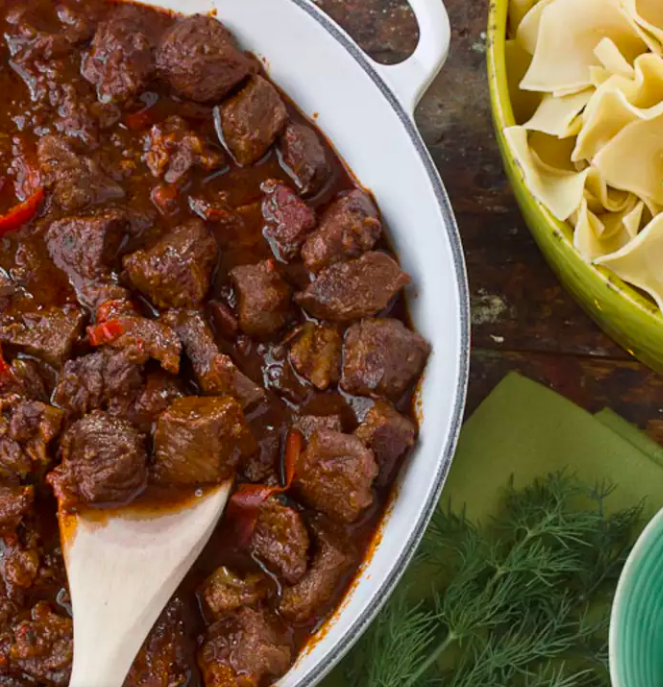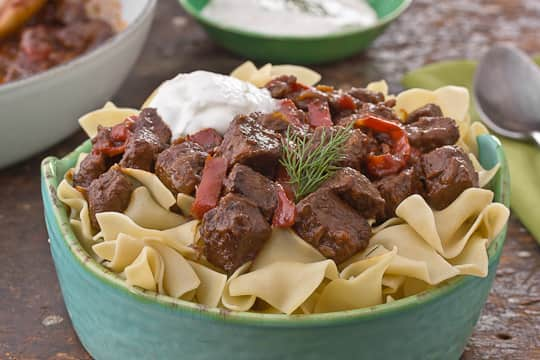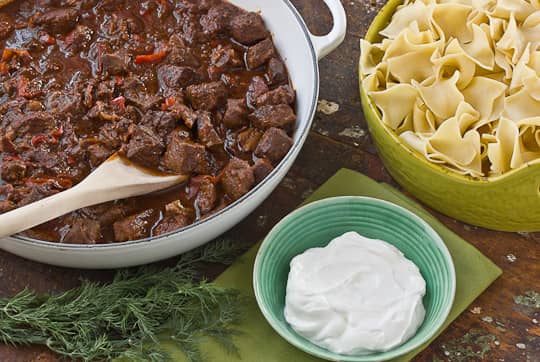
Late Winter Recipe: Beef Goulash

Technically there is no definitive recipe for goulash. There are as many variations as there are cooks, each one different from the last. The two most well-known versions (at least to me) are Hungarian goulash and American goulash. Per usual, our stateside representation bears little resemblance to its Eastern European counterpart, except for a few similar ingredients, and well, the name.
Hungarian goulash, or gulyás, is at its core a soup-stew hybrid, and it can probably be agreed upon that — at the bare minimum — it contains a type of stewing meat along with onions and Hungarian sweet paprika. The rest of the ingredients, however, are up for debate. During my research I came across countless recipes claiming to be authentic: some with tomatoes, carrots or parsnips, and others with peppers, potatoes or none of the above. (So what didthey have in common? They all claimed the others were frauds!)
American goulash on the other hand, more closely resembles “hamburger mac” than “savory European stew.” Pick up any old community cookbook and you’re guaranteed to find a recipe comprised of ground beef, tomato sauce, and elbow noodles. Apparently it was a school cafeteria staple back in the day. (I wish!)
After studying up, I spent some time contemplating the goulash of my dreams. Since my recipe wasn’t going to be authentic, per se, I knew it was imperative that it be really, really good. I began my quest by compiling a laundry list of ingredients to consider, ranging from essential to unnecessary. I made a separate list containing the physical qualities I deemed critical: a thick, glossy sauce; a prominent “Eastern European” sweet-and-savory flavor; and visible, melt-in-your-mouth morsels of beef. I cross-referenced these lists with a few of my best “braised” recipes (including a hearty beef and been chili and a classic beef stew) in order to come up with the ultimate combination of taste and technique.
I started with good-quality ingredients, beginning first and foremost with the meat. I chose thick applewood-smoked bacon along with a chuck-eye roast, a cut that is especially tender and flavorful when stewed. I also bought a brand-spanking-new tin of Hungarian paprika, because an dusty can from the back of my spice cabinet just wouldn’t do. I thawed the last container of prized beef stock I’d been hoarding, to add a little “something special” at the end. With my ingredients in order, I was ready to begin.
As with any great braise, patience is absolutely key. The success of this recipe comes from its complexity, a result of slowly and carefully building layers of flavor in each and every step. Time consuming? Yes. Totally worth it? Absolutely. And hey, this may not be “authentic” Hungarian goulash (according to Wikipedia it is actually pörkölt, but who would even know to Google search that on this side of the pond) but even so, it’s still authentic to me.
This hearty, well-rounded stew is guaranteed to keep you warm on the chilliest of days. I consider it the perfect meal to usher out Old Man Winter, because pretty soon it’ll be time to start gearing up for spring!

Beef Goulash
SERVES 6
INGREDIENTS
- 2 1/2 pounds boneless beef chuck (preferably chuck-eye roast or chuck tender)
- 4 ounces (about 4 thick-cut slices) bacon, roughly chopped
- Neutral cooking oil, such as canola or safflower
- 3 yellow onions (about 1 pound), sliced into thin half moons
- 4 to 5 cloves garlic, minced or pressed
- 2 teaspoons caraway seeds (optional)
- 3 tablespoons Hungarian sweet paprika
- 2 tablespoons tomato paste
- 2 teaspoons dried marjoram
- 1/2 cup dry red wine, such as Chianti or Zinfandel
- 2 cups good-quality chicken stock, preferably homemade
- 1 1/2 cups good-quality beef stock, preferably homemade (See Recipe Notes)
- 2 red bell peppers, sliced lengthwise into thin strips
- Kosher salt and freshly ground black pepper
- 12 ounces wide egg noodles, cooked according package directions
- 8 ounces sour cream, for serving
- Fresh dill, for garnish
INSTRUCTIONS
- Preheat oven to 300°F.
- Cut beef into 1-inch cubes. (You can place the meat in the freezer for thirty to forty minutes to make make it easier to cut. Just allow it to come to room temperature before cooking.) Thoroughly pat dry with paper towels and season generously with kosher salt and pepper.
- Heat a large Dutch oven over medium-high heat. Add the bacon and fry until crisp and golden, about 7-9 minutes. Remove the bacon with a slotted spoon, leaving the remaining fat in the pot, and set aside.
- Add 1/3 of the beef cubes to the bacon fat (do not stir or disturb the meat) and cook until the bottoms are seared and deep golden brown (almost black), about 3-5 minutes. Turn beef and continue cooking until remaining sides are browned, another 3-5 minutes. Remove the beef to a separate bowl.
- Allow the fat in the pan to reheat for a minute or so (and to cook out any residual meat juices before continuing. Add the next 1/3 of beef and a glug or two of oil if the pot seems dry. Repeat the searing process until all the meat is browned and set the bowl aside.
- Lower the heat to medium and add a couple tablespoons oil. Add the onions and sauté, stirring occasionally, until soft and golden, about 8-10 minutes. Add the garlic and caraway seeds and sauté for another minute or so. Stir in the paprika, tomato paste, and marjoram until combined.
- Pour in the wine and increase heat to high. Scrape the bottom of the pot with a wooden spoon to remove any leftover browned bits. Add stocks, browned beef, and reserved bacon to the pot and bring mixture to a boil. Cover and transfer to oven. Cook for 1 hour, then stir in the bell peppers. Return to the oven and continue cooking until the meat is quite tender, another 45 minutes to an hour. Season with salt and pepper to taste.
- Ladle over cooked egg noodles, and serve with a big dollop of sour cream and a sprig of fresh dill. This recipe is even better made a day or two in advance. Just reheat in the same Dutch oven over medium-low to medium until warmed through.
RECIPE NOTES
If you don’t have access to homemade or good-quality beef stock, replace it with an additional 1 1/2 cups chicken stock.
